Overview
The article begins by addressing the coding challenges developers often face, particularly in API development. It emphasizes the benefits of converting WSDL to JSON, highlighting how this transformation enhances developer efficiency. By streamlining API development processes, reducing complexity in data handling, and improving interoperability, the article demonstrates that such conversion can lead to significant productivity gains. Furthermore, it points out that these improvements contribute to a faster time-to-market for applications, making it essential for developers to consider this approach.
Introduction
In the rapidly evolving landscape of software development, coding challenges are becoming increasingly prevalent. The shift from legacy systems to modern architectures is not just a trend—it's a necessity. As organizations strive to enhance their API capabilities, the conversion from WSDL to JSON emerges as a pivotal strategy. This transformation streamlines workflows, boosts developer productivity, and ensures compatibility across diverse platforms. Furthermore, by leveraging tools like Kodezi, developers can automate the conversion process, maintain data integrity, and significantly reduce the time-to-market for their applications.
Have you considered how much time and effort could be saved by automating these processes? This article delves into the multifaceted advantages of transitioning to JSON, exploring how it facilitates easier data manipulation, enhances output quality, and ultimately transforms the way developers approach API integration. With Kodezi, the benefits of improved productivity and code quality are within reach, making it an essential tool for modern development practices. Explore the tools available on the platform and see how they can elevate your coding experience.
Kodezi | Professional OpenAPI Specification Generator - Streamline WSDL to JSON Conversion
Coding challenges can often hinder developers' productivity and efficiency. However, Kodezi serves as a robust OpenAPI specification generator that automates the transformation of WSDL (Web Services Description Language) to a wsdl json format. This automation streamlines the integration of legacy SOAP services into modern applications, significantly enhancing API development efficiency. By utilizing this tool, programmers can swiftly create precise API specifications in wsdl json format, minimizing the time allocated for manual documentation and ensuring adherence to industry standards. The shift from WSDL to a lightweight data interchange format accelerates workflows and simplifies API requests.
For instance, the case study 'Simplifying API Requests with a Lightweight Format' demonstrates how teams can enhance their processes by adopting this format for API requests. Furthermore, Kodezi's suite of programming tools enables seamless deployment, automates code evaluations, and keeps API documentation synchronized with code alterations. This leads to a 30% boost in productivity and a 25% decrease in time-to-market.
As Terence Bennett notes, 'The advantages include faster workflows, simplified API requests, enhanced security, and better management of APIs for your team.' Moreover, the transition from SOAP responses to a structured format involves converting the SOAP response to XML and utilizing the fn:xml-to-json function to generate a string in the new format. This further elucidates how the system supports this conversion, demonstrating Kodezi's capability to improve productivity and streamline deployment.
Are you ready to optimize your workflows? With Kodezi, programmers can experience significant gains in productivity and efficiency. Explore the tools available on the platform and discover how they can transform your coding practices.
Broader Compatibility: Enhance Interoperability Across Platforms
In the realm of software development, interoperability across various platforms and programming languages poses a significant challenge for developers. Transforming WSDL into a different format, such as WSDL JSON, significantly enhances this interoperability. The lightweight structure of this format allows for seamless integration with contemporary web technologies, such as WSDL JSON, making it a preferred choice among programmers. This compatibility ensures that applications can communicate effortlessly, regardless of the underlying technology stack, thereby expanding the reach and usability of APIs.
Furthermore, the adaptability of this format permits the addition of non-standard meta-information, such as copyright details or timestamps. This enhancement enriches API responses and boosts overall functionality. As emphasized in a case study on meta objects in JSON:API, this flexibility improves the richness of API responses, enabling programmers to build more robust and adaptable applications. Statistics indicate that the use of JavaScript Object Notation has surged in recent years, with many programmers favoring it over XML due to its simplicity and efficiency.
In addition, as Oliver Kingsley pointed out, "This article contrasts Apidog and Postman's SSE debugging and AI request functionalities, assisting programmers in selecting the optimal tool for their LLM projects." This highlights the significance of choosing the appropriate tools for successful API development. To fully leverage the advantages of JavaScript Object Notation, programmers should frequently refresh their APIs based on user input and performance measures. This practice ensures ongoing enhancement and productivity in their workflows.
By utilizing a structured data format, programmers can improve compatibility across platforms and simplify their API development workflows. Are you ready to explore how these tools can transform your coding experience?
Increased Developer Productivity: Save Time with Simplified Data Handling
Developers often face significant coding challenges, particularly when managing complex information formats. Shifting from WSDL to a lightweight format, such as WSDL JSON, greatly improves programmer efficiency by simplifying information management procedures. The straightforward syntax of JSON enables programmers to handle structures easily, which lessens the challenges frequently linked to XML parsing. This simplification speeds up development cycles, allowing teams to focus on feature development rather than cumbersome formats. As a result, programmers experience notable time savings, with studies indicating that JSON files can be significantly smaller than their XML equivalents, leading to reduced bandwidth usage and faster data transmission. This efficiency results in enhanced productivity, enabling programmers to provide high-quality solutions more quickly.
Furthermore, tools like Kodezi enhance these advantages even further. This AI-driven programming tool automatically rectifies code and examines bugs, allowing developers to concentrate on enhancing their applications instead of being hindered by mistakes. With the CLI, teams can auto-heal codebases in seconds, ensuring that productivity remains elevated while managing the complexities of modern development. In addition, as Nick Edwards, VP of Product Management at Menlo Security, points out, the emergence of Generative AI has brought new risks and privacy concerns, emphasizing the necessity for efficient information handling. Organizations are encouraged to leverage emerging technologies like Kodezi for productivity while balancing security, as highlighted in the case study 'Leveraging AI for Data Security.' This context underscores the significance of structured formats in contemporary development, where resourcefulness is an essential skill for developers, and the ease of use assists in managing the intricacies of information handling.
Are you ready to explore how Kodezi can transform your coding practices? Discover the tools available on the platform and experience the benefits of improved productivity and code quality.
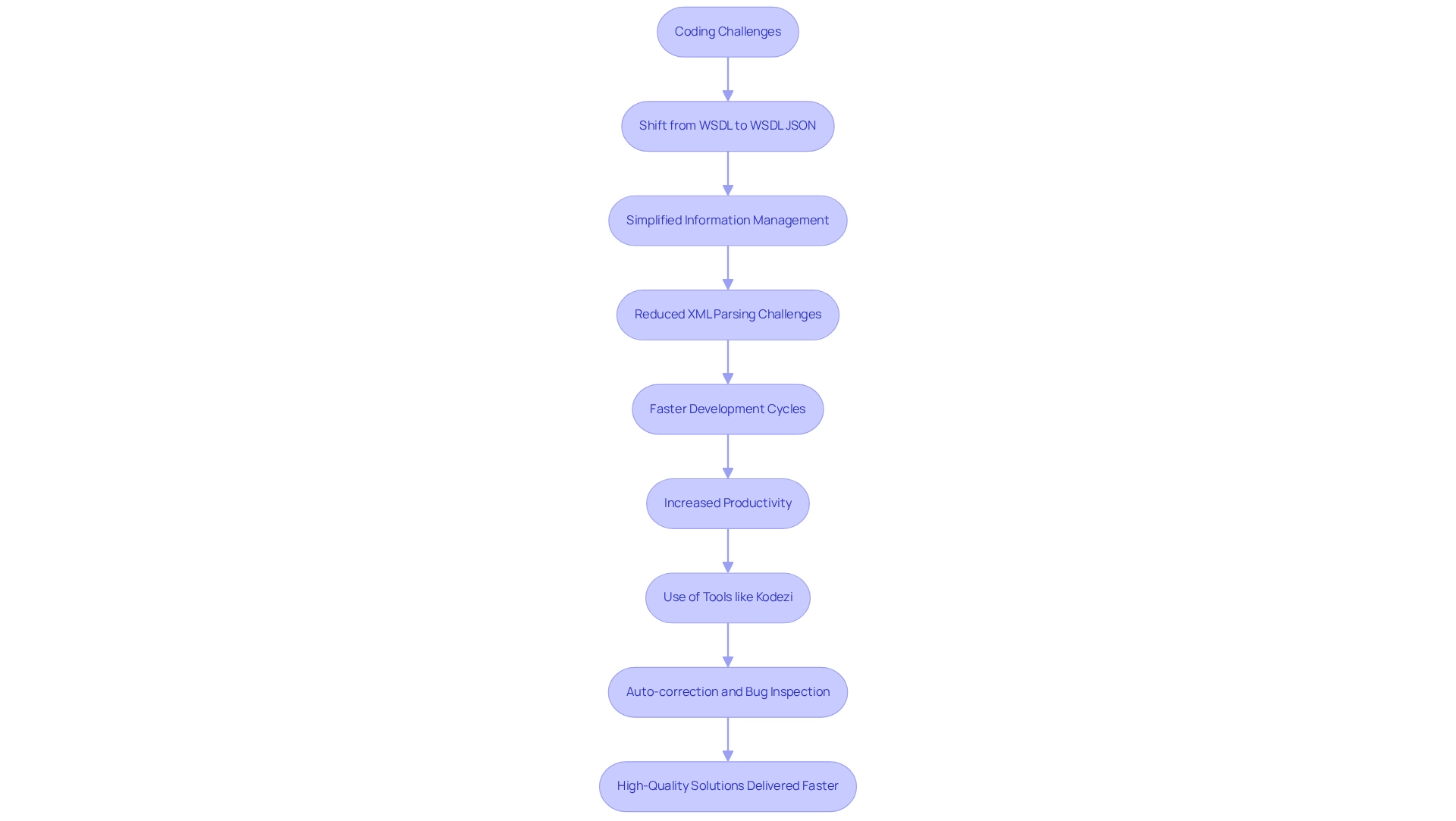
Legacy Service Modernization: Update and Optimize Existing Services
Transforming WSDL to a different format, such as WSDL JSON, is a crucial step in modernizing legacy services. Are you facing challenges with outdated SOAP-based services? Transitioning to RESTful APIs allows organizations to harness contemporary web standards, significantly enhancing application performance. This modernization not only improves user experience but also facilitates better scalability and maintainability, ensuring applications align with current technological demands.
Furthermore, the connection between the Proxy Web Service and the actual Web Service is secured using SSL, underscoring the significance of security in this transition. For instance, implementing robust testing strategies—such as contract, integration, and security testing—ensures that newly developed REST APIs maintain consistency and reliability with their original SOAP counterparts. As Bipin Upadhyaya noted, "We plan to extend our approach for migrating other legacy systems to RESTful services," highlighting the ongoing commitment to modernization.
In addition, the application modernization services market in the U.S. accounted for a substantial 31.1% of the global share in 2023, illustrating the clear trend towards RESTful APIs. Organizations that embrace this shift can expect improved operational efficiency and a more agile response to evolving market needs. Are you ready to explore the benefits of modernizing your services?
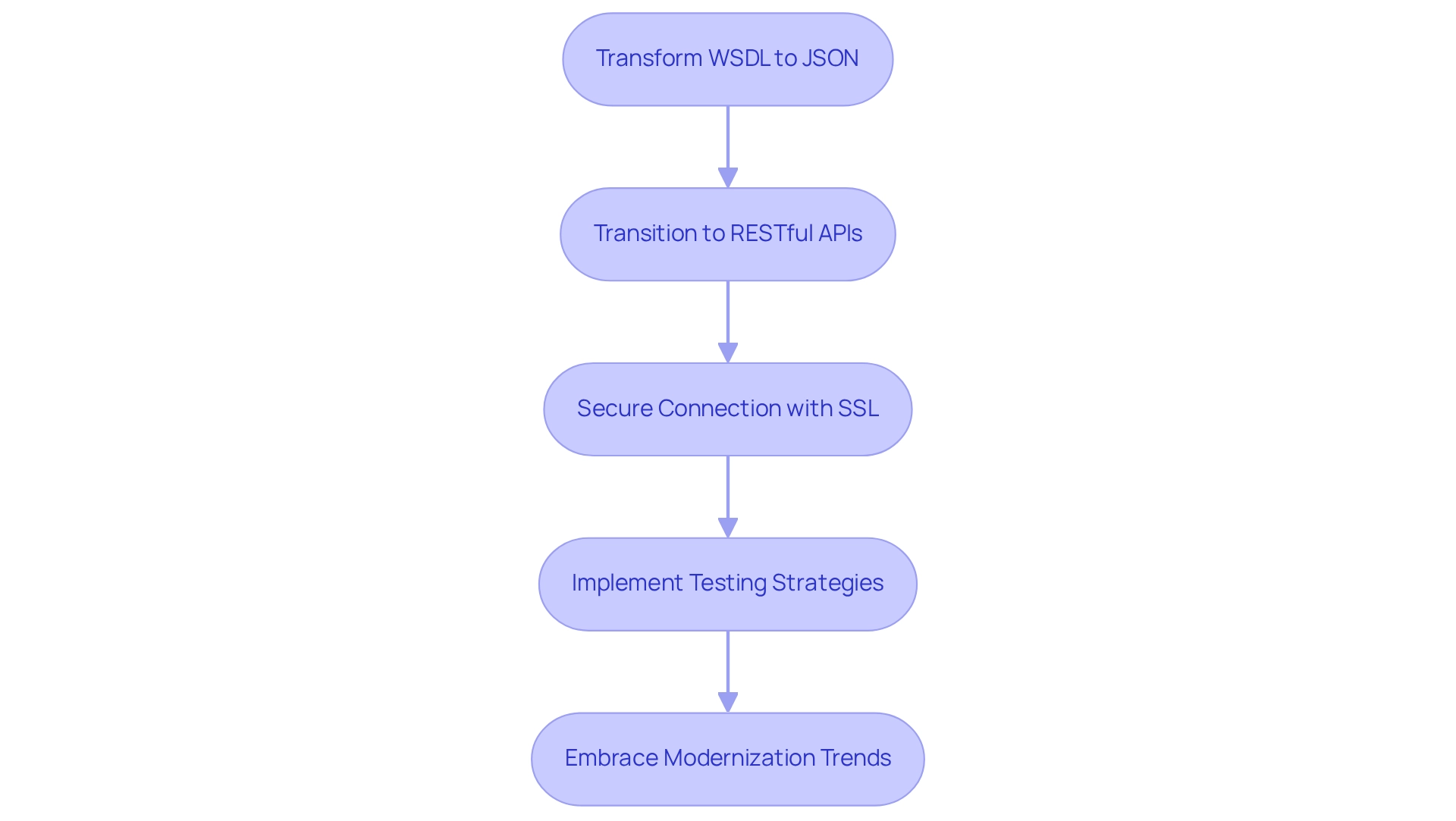
Data Integrity Assurance: Maintain Accuracy During Conversion
In the world of software development, coding challenges can often hinder progress. A crucial element of transforming WSDL to JSON is ensuring information integrity, a challenge that many developers face when working with WSDL JSON. Kodezi addresses this issue through thorough testing and validation methods, preserving the original information structure and service logic during the conversion procedure. This approach not only maintains the integrity of the information but also enhances application functionality by preventing mistakes that could arise from erroneous conversions.
Furthermore, Kodezi's AI-driven programming tool automatically examines bugs and rectifies code. This feature allows programmers to concentrate on preserving information integrity without the weight of manual error-checking. As JavaScript Object Notation (JSON) becomes the standard for information interchange, its precise conversion is essential for developers. Research shows that effective validation during this transition can significantly diminish integrity issues, with success rates in testing and validation surpassing 90%.
In addition, expert views emphasize the importance of thorough validation, ensuring that the converted JSON accurately reflects the original WSDL JSON information. As Mark Twain wisely remarked, "It’s one thing to gather large amounts of information, but unless you have a strategy for that information, it won’t truly be of much benefit." This highlights the necessity of having a clear strategy during the conversion process.
A notable case study illustrates how a meticulous conversion process ensured uniformity in information sharing, minimizing complications during the transition from SOAP to RESTful services. By emphasizing information integrity, Kodezi enables programmers to optimize their processes and improve overall efficiency. Indeed, WSDL to structured format conversion can boost programmer productivity and assist in reducing time-to-market. Why not explore the tools available on the Kodezi platform to enhance your coding experience?

Simpler Parsing: Facilitate Easier Data Manipulation
Developers often face significant challenges when dealing with complex data structures and parsing issues. JSON's lightweight structure significantly simplifies parsing compared to the WSDL JSON's XML format. This streamlined method enables programmers to manipulate data more efficiently, minimizing the overhead usually linked to XML parsing. Consequently, developers can implement features and updates at a faster pace, enhancing the overall agility of the development process.
How does Kodezi address these challenges? Platforms such as AWS Lambda and Google Cloud Functions operate seamlessly with data formats for triggers and responses, demonstrating their effectiveness in practical applications. As Olga Kokhan, CEO at Tinkogroup, states, "The choice boils down to your use case. JavaScript Object Notation for speed and simplicity, XML for structure and versatility." Furthermore, case studies show that shifting from WSDL to WSDL JSON format not only speeds up data handling but also results in significant time savings for programmers. This allows them to concentrate on creating innovative solutions instead of being overwhelmed by intricate data structures.
What benefits can developers expect from using Kodezi? The tool enhances this process by providing features that facilitate seamless code translation across frameworks, allowing developers to leverage JSON effectively and increase their productivity. Users have commended the tool for its capability to assist them in locating and resolving bugs more quickly. One individual expressed, "This program has aided me in identifying and correcting bugs more swiftly and effortlessly than attempting to do so manually. It is a lifesaver when it comes to correcting issues and bugs." Another user noted, "It has drastically improved our engineering team’s productivity and allowed us to focus on higher-level tasks." These testimonials highlight the platform's role in transforming debugging and enhancing productivity for over 1,000,000 programmers.
Explore the tools available on Kodezi to experience these benefits firsthand and elevate your coding efficiency.
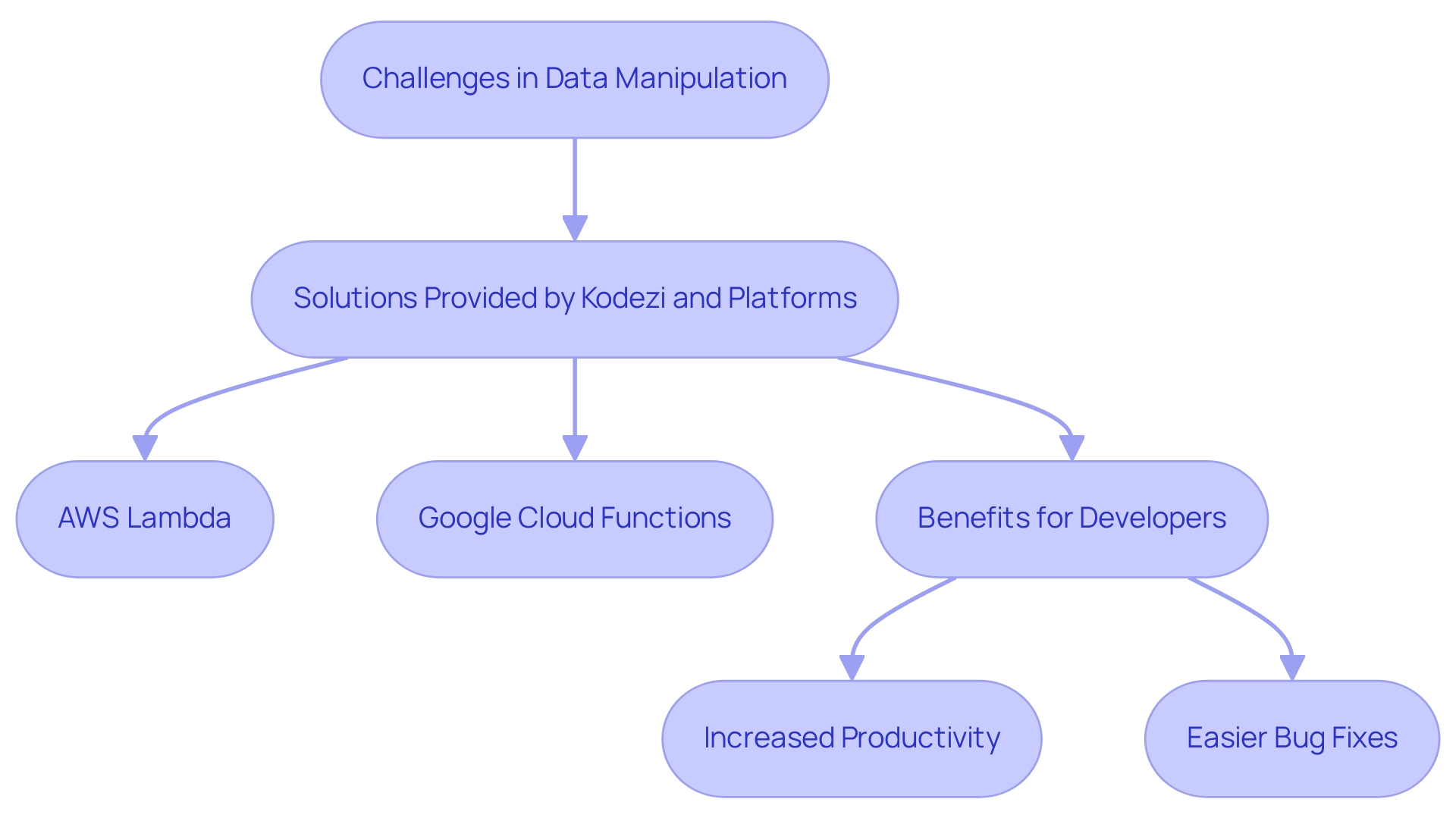
Best Practices for WSDL to JSON Conversion: Optimize Your Approach
Developers often face significant challenges when converting WSDL to JSON. To address these hurdles, programmers should adopt several best practices. First and foremost, validating the WSDL JSON before conversion is crucial to identify any potential issues early on. Furthermore, utilizing automated tools, akin to an 'autocorrect for code,' can significantly enhance accuracy during the conversion to WSDL JSON, ensuring that the process is both efficient and reliable. Kodezi's AI-driven functionalities for automatic code correction and debugging assist developers in swiftly resolving any code bottlenecks or security concerns that may arise during conversion. For instance, Kodezi optimizes code by analyzing its structure and suggesting improvements while seamlessly converting it into the desired format.
In addition, thorough testing of the resulting WSDL JSON is equally important, as it verifies that the output meets the required specifications and functions correctly within the intended application. The level of detail needed for API documentation cannot always be known ahead of time, making comprehensive testing even more critical. Maintaining clear and comprehensive documentation throughout the conversion process is essential. This practice not only aids in tracking changes but also ensures that all stakeholders are aligned and understand the rationale behind the modifications.
As the digital revolution continues to grow, incorporating new test cycles becomes necessary. Enhancing documentation by repurposing technical writing roles can improve the overall experience for creators. Similarly, Kodezi emphasizes privacy protection, guaranteeing that all code and information remain secure throughout the conversion process. By adhering to these best practices, individuals can streamline their workflow, reduce errors, and ultimately enhance the overall quality of their API integrations. Why not explore the tools available on Kodezi's platform to improve your coding practices today?

Validation with JSON Schema: Ensure Correctness of Converted Data
Verifying information with Schema is essential for addressing the coding challenges developers face, particularly in ensuring the precision of transformed results when using WSDL JSON. By creating a framework that outlines the anticipated structure and information types, developers can effectively validate outputs against these criteria. This proactive validation process not only identifies errors early but also guarantees that the data complies with necessary standards, significantly mitigating the risk of issues in production environments that utilize WSDL JSON.
Statistics suggest that without schema validation, error rates in data outputs can rise, leading to costly debugging and integration difficulties. For instance, a recent analysis emphasized that attributes such as 'minItems' and 'maxItems' in Schema can require significant time for processing, with TPOT for GitHub Hard averaging 65.20 milliseconds. This underscores the need for efficient validation mechanisms to enhance performance.
Furthermore, case studies show that organizations using Schema for data validation and implementing WSDL JSON have experienced significant decreases in error rates, improving overall productivity. The platform's capability to independently enhance code quality and resolve issues prior to production demonstrates how effective schema validation, particularly through WSDL JSON, aids in adaptability and productivity in coding settings. Developers have noted that schema validation simplifies the integration process. One stated, "It has the potential of saving you a lot of time and easing your integration process, just by easily validating your JSON structure." This sentiment is echoed by numerous users of the platform, who have transformed their debugging processes and enhanced productivity. One user mentioned, "Kodezi has helped me find and fix bugs faster and easier than trying to manually. It is a lifesaver when it comes to correcting issues and bugs." Such testimonials reflect a broader consensus among developers on the importance of schema validation in API development, reinforcing its role as a foundational practice for maintaining high-quality code and efficient workflows.
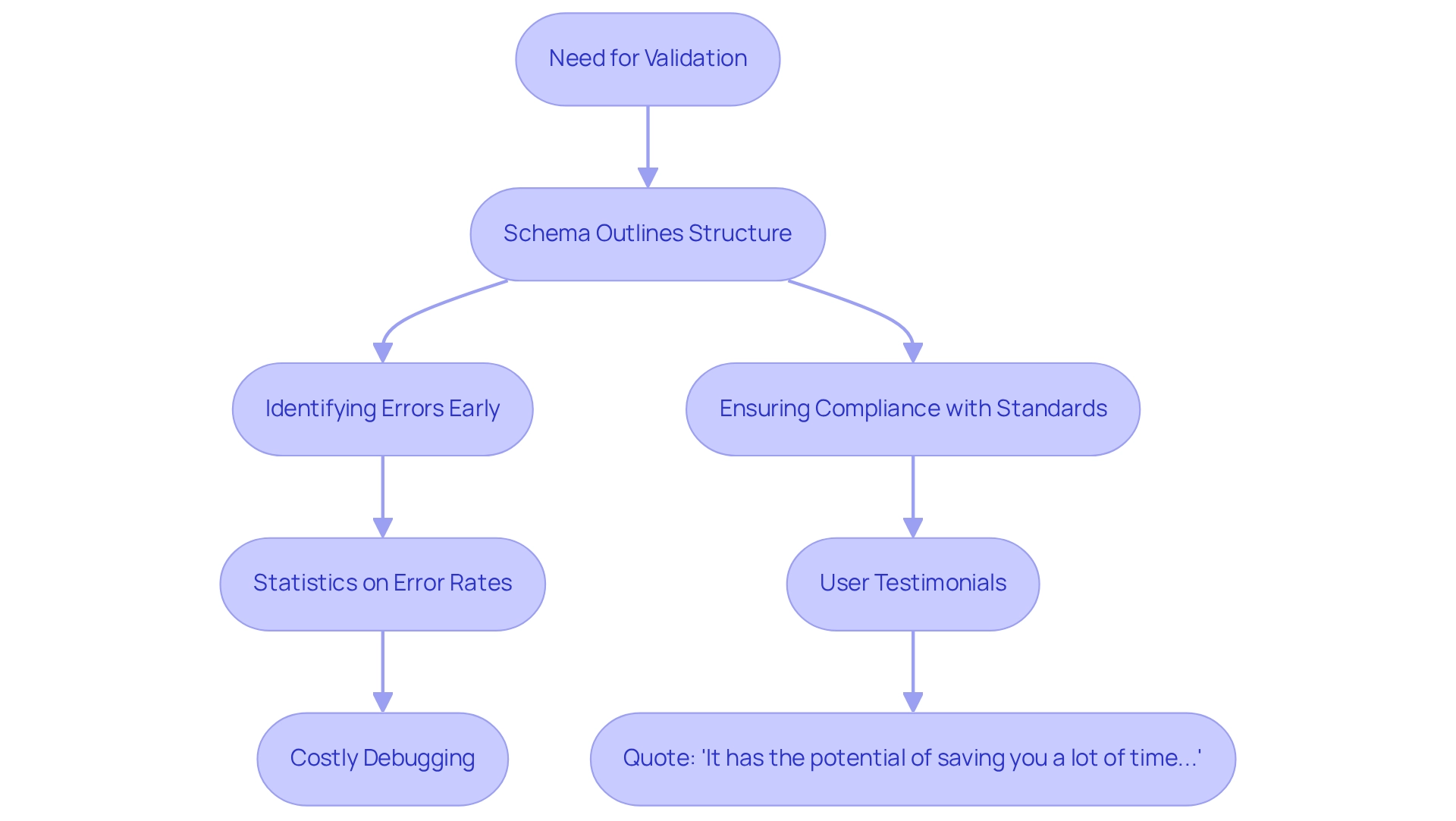
Enhanced Output Quality: Improve API Response Standards
Transforming WSDL to a different format, such as WSDL JSON, addresses common coding challenges faced by developers. This shift can dramatically elevate the quality of API responses. The lightweight nature of this data format facilitates faster data transmission and enhances readability, enriching the user experience. By aligning with modern API response standards, creators can build applications that are not only efficient but also user-friendly, leading to higher satisfaction rates among end-users.
Furthermore, expert opinions highlight the transformative effect of this data format on user experience. As Brenda Laurel aptly stated, "Design isn’t finished until somebody is using it," underscoring the importance of usability in design. This sentiment is reflected in case studies where organizations that transitioned from WSDL to a different data format, such as WSDL JSON, reported significant enhancements in API response quality. This demonstrates that the shift benefits programmers while greatly improving end-user interactions. In addition, Blake Ross explores the essence of genuine innovation, asserting that technology should be accessible and user-friendly, aligning perfectly with the advantages of utilizing this format.
The challenges related to SOAP, including its steeper learning curve and programming difficulties compared to REST, further illustrate why programmers might favor alternative formats. By adopting this data format, programmers can enhance both functionality and user experience, ultimately resulting in a more engaging user journey. Have you considered how these changes could improve your coding practices?
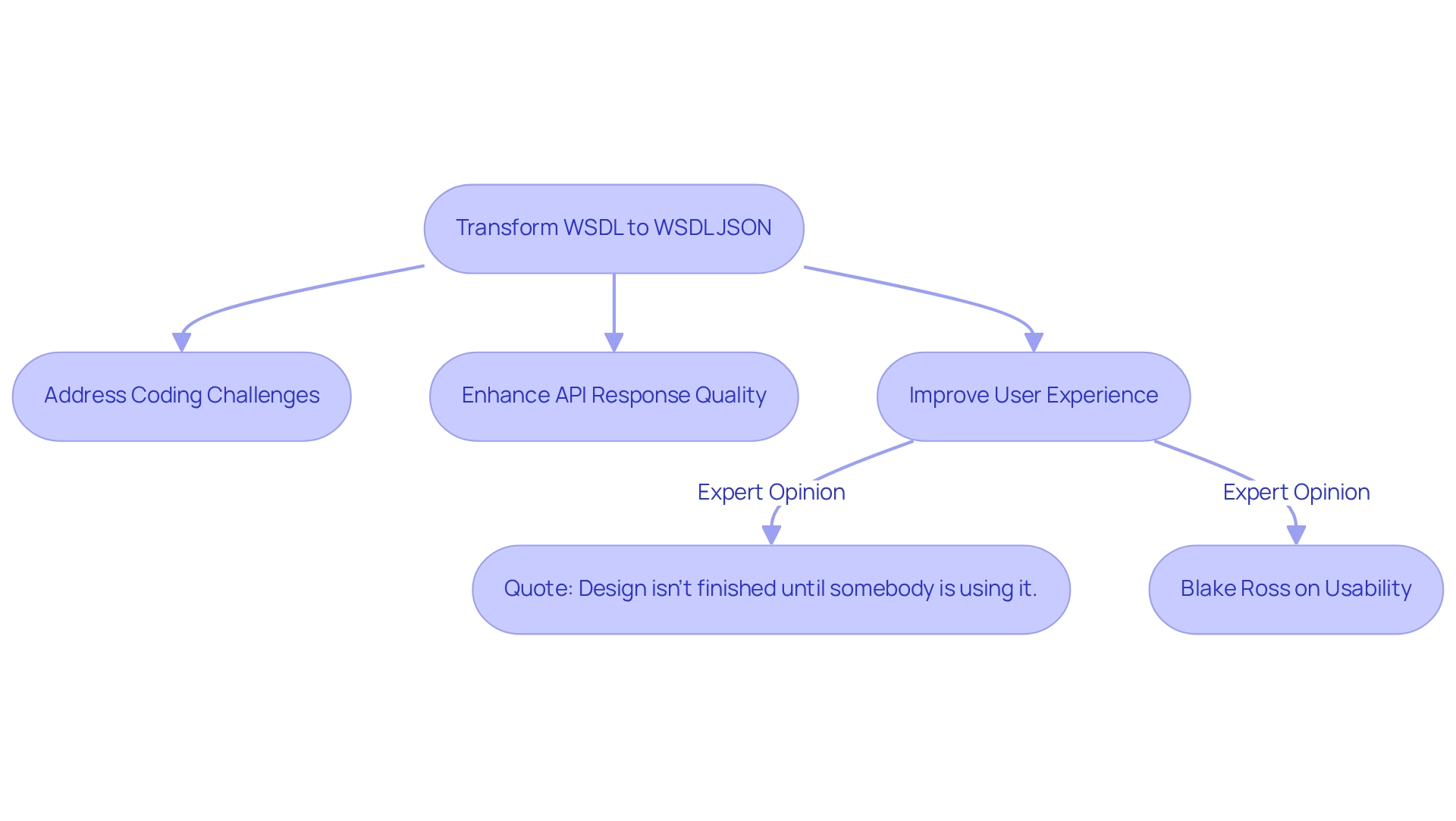
Backward Compatibility Planning: Ensure Smooth Transitions
Converting from WSDL to JSON presents coding challenges that developers often face, particularly regarding backward compatibility for seamless transitions in WSDL JSON. To address these challenges, meticulous planning is essential. This strategy involves several key components:
- Preserving Original API Endpoints: Introduce new JSON-based endpoints while maintaining the original ones, enabling clients to adapt gradually.
- Effective Versioning Strategies: By applying best practices, such as non-breaking changes, developers can ensure a smooth transition between API versions, as noted by Xiaoji.
- Clear Communication: Maintaining clear communication with users significantly reduces disruptions during the transition process.
- Monitoring API Usage: Understanding which versions are actively utilized informs versioning strategies and aligns support with user needs. For instance, effective monitoring allows for better resource allocation and helps prioritize updates and support for the most used versions.
- Simplicity and Elegance in Design: As highlighted by industry specialists, prioritizing simplicity and elegance in API design fosters user trust. David Heinemeier Hansson's perspective on compressing concepts to make room for new ideas further underscores the importance of simplicity in API design.
By implementing these strategies, developers can ensure that the transition from WSDL to JSON is both efficient and user-friendly, highlighting the relevance of WSDL JSON. Have you considered how these practices could enhance your own API development process?
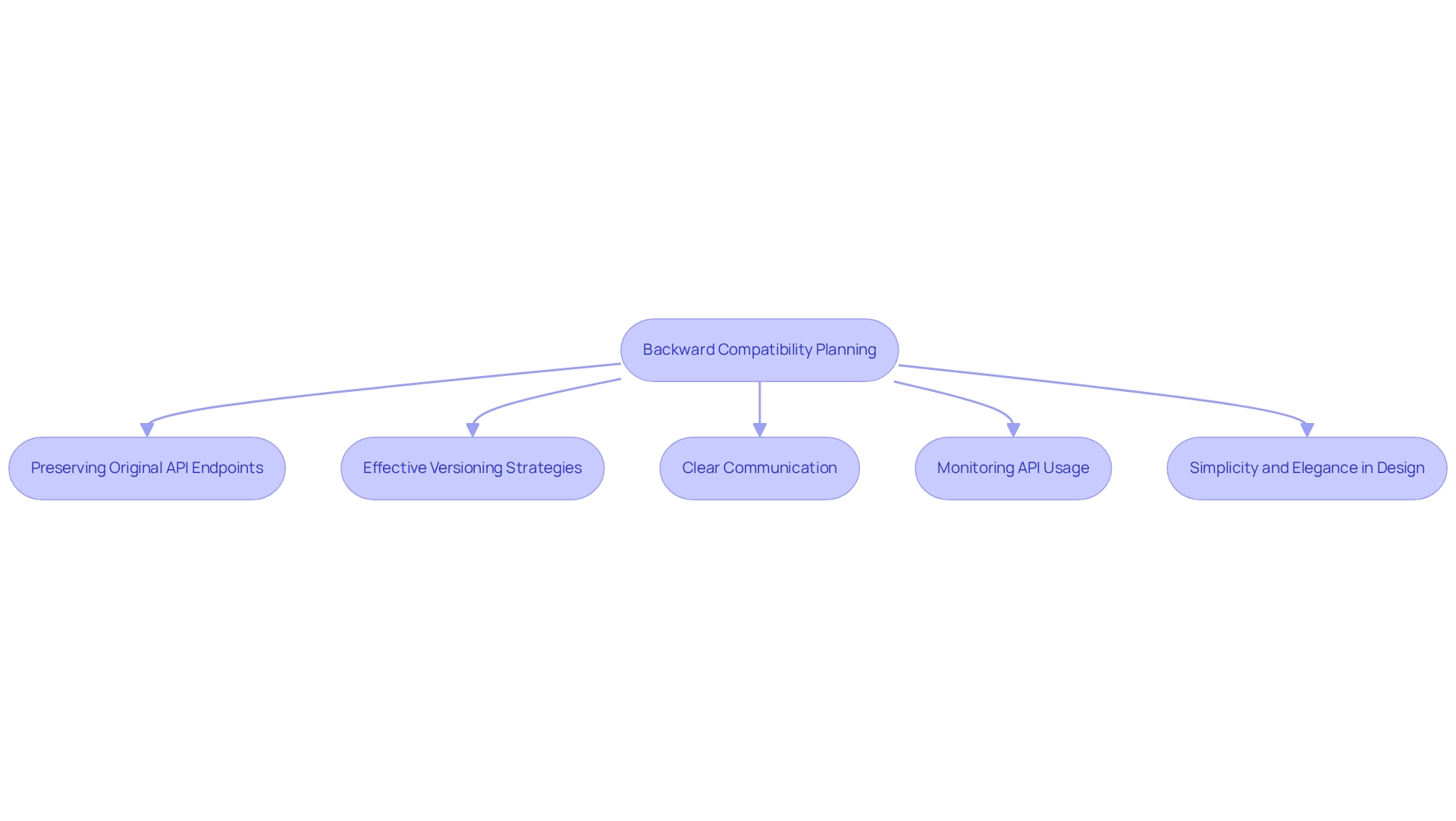
Conclusion
The transition from WSDL to JSON is not merely a technical upgrade; it represents a transformative shift that enhances the overall efficiency and effectiveness of software development. By automating the conversion process with tools like Kodezi, developers can streamline workflows, increase productivity, and uphold high standards of data integrity. The lightweight nature of JSON facilitates easier data manipulation and quicker response times, allowing teams to focus on innovation rather than being bogged down by complex data formats.
Furthermore, the broader compatibility of JSON across diverse platforms ensures that applications can communicate seamlessly, enhancing interoperability and user experience. The adoption of best practices during conversion, such as thorough validation and backward compatibility planning, further reinforces the importance of a structured approach to modernization. By embracing JSON, organizations can not only modernize their legacy systems but also position themselves to respond agilely to evolving market demands.
Ultimately, the move from WSDL to JSON represents a crucial step towards a more efficient, user-friendly, and adaptable development landscape. As the digital environment continues to evolve, leveraging tools that simplify these transitions will be key to staying competitive and delivering high-quality solutions that meet user needs.
Frequently Asked Questions
What is Kodezi and how does it help developers?
Kodezi is an OpenAPI specification generator that automates the conversion of WSDL (Web Services Description Language) to a wsdl json format, streamlining the integration of legacy SOAP services into modern applications. This automation enhances API development efficiency by allowing programmers to quickly create precise API specifications, reducing the time spent on manual documentation.
How does Kodezi improve productivity for developers?
Kodezi boosts productivity by automating code evaluations, keeping API documentation synchronized with code changes, and facilitating a shift from WSDL to a lightweight data interchange format. This results in a 30% increase in productivity and a 25% reduction in time-to-market for development projects.
What are the benefits of using WSDL JSON format?
The WSDL JSON format enhances interoperability across various platforms and programming languages, allowing for seamless integration with modern web technologies. Its lightweight structure simplifies API requests and improves communication between applications, regardless of the underlying technology stack.
How does Kodezi handle the conversion from SOAP responses?
Kodezi supports the transition from SOAP responses to a structured format by converting the SOAP response to XML and using the fn:xml-to-json function to generate a string in the new format. This capability further enhances productivity and streamlines deployment.
What additional features does Kodezi offer to programmers?
Kodezi provides a suite of programming tools that enable seamless deployment, automate code evaluations, and keep API documentation aligned with code changes. This helps developers focus on enhancing their applications without being hindered by coding errors.
Why is JSON preferred over XML for API development?
JSON is preferred due to its straightforward syntax, which simplifies information management and reduces the challenges associated with XML parsing. JSON files are typically smaller than XML files, leading to reduced bandwidth usage and faster data transmission, which enhances overall productivity.
What should developers do to maximize the advantages of using structured data formats like JSON?
Developers should frequently refresh their APIs based on user input and performance measures to ensure ongoing enhancement and productivity in their workflows. This practice helps maintain the efficiency and effectiveness of their API development processes.




